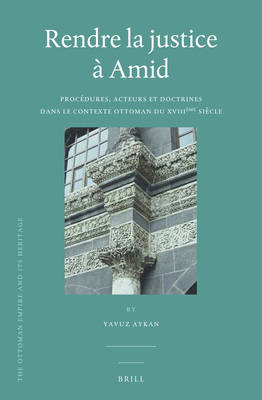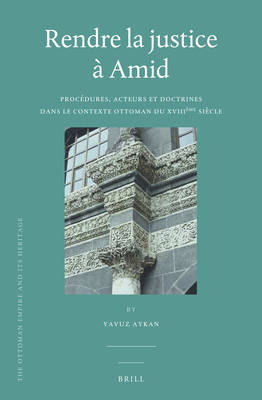
- Afhalen na 1 uur in een winkel met voorraad
- Gratis thuislevering in België vanaf € 30
- Ruim aanbod met 7 miljoen producten
- Afhalen na 1 uur in een winkel met voorraad
- Gratis thuislevering in België vanaf € 30
- Ruim aanbod met 7 miljoen producten
Zoeken
Rendre La Justice À Amid
Procédures, Acteurs Et Doctrines Dans Le Contexte Ottoman Du Xviiième Siècle
Yavuz Aykan
€ 238,45
+ 476 punten
Omschrijving
Dans son Rendre la justice à Amid, Yavuz Aykan analyse la vie juridique de la ville d'Amid, capitale de la province ottomane de Diyarbakir, au 18ème siècle. A partir des procès-verbaux des tribunaux des villes d'Amid, Harput et Mardin, il met en lumière la centralité du cadi, du gouverneur provincial (vali) et du mufti dans le champ opératoire de la loi. Retraçant la généalogie des textes utilisés par le mufti provincial, Aykan étudie aussi la circulation de diverses interprétations juridiques de la Grande Syrie à la Transoxiane et la Horde d'Or, et leur intégration dans la pratique juridique ottomane. Ce livre offre ainsi une approche renouvelée et historicisée des acteurs et hiérarchies de systèmes juridiques de ce cadre provincial.
In Rendre la justice à Amid, Yavuz Aykan analyses the legal life of the city of Amid, the capital of Ottoman Diyarbekir province in the 18th century. Making use of court records from the cities of Amid, Harput and Mardin, he explores the centrality of the qadi, the provincial governor, and the provincial mufti to law enforcement. By tracing the genealogies of legal texts used by the mufti for fatwa production, Aykan maps out the broader transformations of various judicial interpretations in their journey from Greater Syria to Transoxiana and the Golden Horde, and finally into Ottoman legal praxis. As such, this book offers a far more historicized approach to the multiple actors and hierarchies of juridical systems operating in this provincial setting.
In Rendre la justice à Amid, Yavuz Aykan analyses the legal life of the city of Amid, the capital of Ottoman Diyarbekir province in the 18th century. Making use of court records from the cities of Amid, Harput and Mardin, he explores the centrality of the qadi, the provincial governor, and the provincial mufti to law enforcement. By tracing the genealogies of legal texts used by the mufti for fatwa production, Aykan maps out the broader transformations of various judicial interpretations in their journey from Greater Syria to Transoxiana and the Golden Horde, and finally into Ottoman legal praxis. As such, this book offers a far more historicized approach to the multiple actors and hierarchies of juridical systems operating in this provincial setting.
Specificaties
Betrokkenen
- Auteur(s):
- Uitgeverij:
Inhoud
- Aantal bladzijden:
- 284
- Taal:
- Frans
- Reeks:
- Reeksnummer:
- nr. 60
Eigenschappen
- Productcode (EAN):
- 9789004292109
- Verschijningsdatum:
- 28/01/2016
- Uitvoering:
- Hardcover
- Formaat:
- Genaaid
- Afmetingen:
- 157 mm x 236 mm
- Gewicht:
- 498 g

Alleen bij Standaard Boekhandel
+ 476 punten op je klantenkaart van Standaard Boekhandel
Beoordelingen
We publiceren alleen reviews die voldoen aan de voorwaarden voor reviews. Bekijk onze voorwaarden voor reviews.








